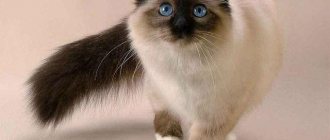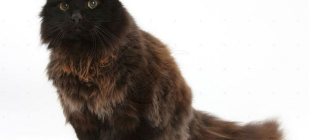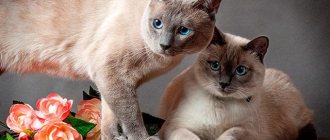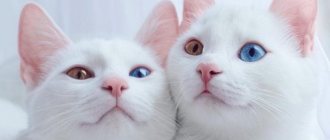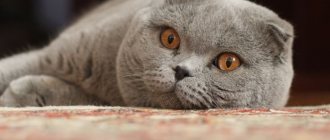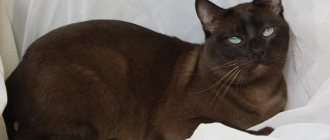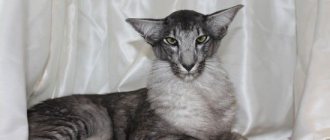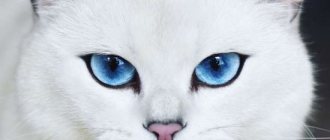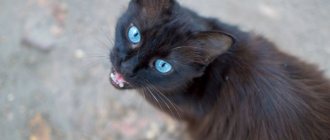Can a human shadow have a tail and four legs? Maybe if there is a Balinese cat in the house, which always follows on its owner’s heels. This graceful cat with expressive almond-shaped eyes moves as gracefully as a Balinese dancer. She loves to be the center of attention and does not tolerate loneliness well.
Balinese cat: description of the breed
Brief history of the breed
America is considered the birthplace of the Balinese. According to one version, they appeared as a result of a gene mutation. According to the second theory, Balineses were bred as a result of mating Angora and Siamese cats.
Serious work on creating a new breed began in 1950 on the initiative of Marion Dorset. Ten years later, Helen Smith joined her and suggested calling the resulting cats Balinese.
For a long time, the breed did not receive official recognition from the public. It was possible to register the Balinese only in 1970 thanks to the persistence and tenacity of the breeders.
Mister Cat Tells: An Origin Story
How the Balinese appeared has not yet been established. It is only known that their homeland is the USA. It is believed that these graceful and intelligent animals are a mixture of Siamese and Angora cats. Perhaps one of the breeders deliberately crossed the two breeds.
Another version is a natural mutation. For a long time, when a kitten with long fur appeared in a litter, this was considered a defect. But in 1940, the American Marion Dorset made a separate breed from these rejected lumps. And in 1950, thanks to the breeder, they began to breed a new variety of cats.
After a while, felinologist Helen Smith also took part in the fate of these cats. The famous animal lover came up with a name for them - balinese. The graceful gait of the pets reminded the woman of the graceful movements of the dancers of Fr. Bali.
In the 70s, a new breed of cat gained recognition in America. A decade later, long-haired beauties conquered Europe, and then the whole world.
Interesting Facts
Although Balinese cats appeared relatively recently, they managed to associate a lot of interesting things with the breed:
- The name of the animals has nothing to do with the area where they were bred. It is associated with the appearance of cats, which with their grace resemble Balinese dancers.
- The color of the coat of representatives of this breed is influenced by a special gene, the activity of which changes with cold weather. Therefore, it is better to keep Balinese dogs in warm rooms with an air temperature of 22-24 °C.
- Kittens of this breed are born with short hair. The guard hair lengthens as the Balinese matures.
Choosing a Balinese kitten and cost
When choosing a pet, you should remember that the Balinese beauty is a blue-eyed cat with a long body, large ears and a long nose. It is similar to the Siamese, but its peculiarity is medium-length hair without a hint of undercoat.
At birth, the Balinese is white. To make sure that a kitten is purebred, you need to see its parents with pedigrees.
It is allowed to breed a Balinese cat only with Siamese, Seychelles and long-haired Orientals. The kitten must have a pedigree and a veterinary record with vaccinations.
What does a Balinese kitten look like?
When buying a Balinese, you need to be extremely careful. They are often given away as long-haired kittens of various origins with a “Siamese” color.
A purebred kitten will not be cheap, from 350 USD. by advance reservation. If the animal does not participate in exhibitions and breeding, then you can buy a pet-class cat. This is the same purebred pet without defects, but it is easier to acquire and will cost much less.
Breed description, standards, appearance
The Balinese cat has a graceful, athletic build and well-developed muscles. Visually, it is very similar to the Siamese, only with longer hair. The first breed standard appeared in 1967. It regulates not only the exterior, but also the behavioral characteristics of the Balinese.
Dimensions and weight
Representatives of the Balinese breed are not large animals. Females weigh on average 3.5 kg. Cats of this breed are heavier: the body weight of an adult male is about 5 kg.
Anatomical characteristics
Pedigree Balinese cats must meet the following description:
- The head is small, wedge-shaped with a narrowed, elongated muzzle, straight profile, pointed chin, high prominent cheekbones and a strong lower jaw.
- The eyes are almond-shaped, expressive, and slanted. The color of the iris is blue or blue.
- The ears are triangular, erect, disproportionately large. They have rounded tips and are a harmonious continuation of the wedge-shaped head.
- The body is stretched, slender with well-developed muscles.
- The limbs are thin, long with small oval paws. The front ones are slightly shorter than the rear ones.
- The tail is thin and long. Visually resembles a whip. Decorated with plumes.
Color and coat type
The body of a Balinese cat is covered with shiny, silky hair. On the chin, tail and neck of the animal, the hair is slightly wavy.
The colors of the Balinese can be varied. The most common colors found in the breed are:
- frost point;
- brown (chocolate) point;
- seal point;
- blue point;
- tabby
On a note. Balinese kittens are born with a uniform coat. The formation of color is completed by 12-18 months.
Possible breed defects
The disadvantages of the exterior of Balinese cats include:
- strabismus;
- kinks on the tail;
- dark spots on the stomach;
- white fingers;
- lack of markings on paws and muzzle;
- solid black or red color.
Balinese dogs with at least one of the above defects are not allowed for exhibitions and are not used for breeding.
Breed standard Balinese cat
Balinese and Siamese are united by a lean type of constitution, but at the same time they are separated by the length of the coat. Ideally, the Balinese cat should have well-developed muscles, at the same time have a sophisticated appearance and not have a loose build. This effect is achieved thanks to the elongated limbs, neck and body, which make the appearance of the purr exquisitely aristocratic.
Head
The head shape of the Balinese cat tends to be a narrowed wedge, starting from the nose and ending at the ears. The skull is flat, even when viewed in profile, without protrusions in the eye area, with a continuous straight line of the nose. The tip of the chin is not slanted, the muzzle is distinctly pointed.
Eyes
The eye shape is classic almond-shaped with a pronounced slope of the inner corners towards the nose. The eyeballs are not set deep, but not protruding either. The iris is colored pure blue.
Ears
Large ears are a natural extension of the head wedge. The base of the ears is very wide, the tips are pointed.
Body
The refined skeleton is covered with developed muscles responsible for flexibility and grace of movements. The body of the Balinese cat is long and elegant. Shoulders and hips are straight, the stomach is tucked. Mandatory condition: the thigh should not be wider than the shoulder girdle.
Neck
The neck of the Balinese is elongated, very slender and graceful.
Legs
Proportional, good length legs end in miniature oval paws. The hind limbs are necessarily higher than the forelimbs. Number of toes: four on the hind feet, five on the front feet.
Tail
Balinese tails are long, thin at the base and have a pointed tip.
Wool
The satin “fur coat” of the Balinese cat has practically no undercoat. Due to the fit to the body, the hair appears shorter than it actually is. The longest hair grows on the tail - the flowing awn on this part of the body forms an elegant, lush plume.
Color
The traditional colors of the Balinese are pointing. The bodies of animals have a solid tone, sometimes complemented by subtle shades. As the cat gets older, the color of the body may gradually darken. Locations of points: muzzle (mask), ears, tail, legs and paws. All point zones are uniformly and intensely colored and have the same color. Unacceptable: tipping points, as well as the presence of light hairs on them. The mask covers the entire muzzle, including the whisker pads, and extends to the ear area in the form of thin lines. Mandatory requirement: the mask should not extend beyond the top of the parietal area of the head.
Disqualifying faults
Balinese will not be able to attend exhibitions if he has:
- double coat with pronounced undercoat;
- eyes of any color except blue;
- white toes or paws;
- obstruction of the nasal passages, due to which the animal breathes through the mouth;
- the number of fingers does not correspond to the number approved by the standard;
- weak hind legs;
- an underdeveloped or excessively protruding chin, resulting in an abnormal bite;
- creases on the tail.
Exhausted and unhealthy animals are not allowed into the ring, so it is important to monitor the condition and general condition of the pet.
Character and temperament
Balinese cats are sociable, curious and intelligent creatures. Thanks to their natural flexibility and acrobatic abilities, they can easily climb tall cabinets and other hard-to-reach places in search of interesting objects.
Balinese cats need constant communication with people and love to be the center of attention. They quickly become attached to their owners and do not tolerate loneliness well.
Balinese cats are not as violent and selfish as their Siamese relatives. By temperament type, representatives of this breed are true sanguines.
Balinese are energetic, active animals that never get discouraged.
Breed and children
The Balinese cat gets along well with the owner's kids. Especially if children understand how to properly communicate with a pet and do not offend it.
He will be happy to play with them. But if the kids start squeezing the Balinese or carrying it in their arms, the cat may show its claws.
Breed and other animals
Balinese cats have always lived close to people and never foraged for food in their natural environment. Therefore, they do not have developed hunting instincts and are calm towards other animals.
Balinese cats get along well with a variety of pets, from dogs to rodents.
Personality of the Balinese cat
The Balinez is an ultra-communicative cat, aimed at establishing friendly relations with humans. Because of their insatiable desire to constantly be present in the life of the owner, purrs are often called boomerangs - no matter where in the apartment you leave your pet, you can be sure that in a couple of seconds he will be sitting next to you. “Loneliness in bed” after the appearance of a Balinese cat in the house is also not a threat. A purring heating pad will protect the owner's sleep throughout the night. Moreover, settling down next to someone is not the only acceptable option for a balinese, because you can also climb onto the owner’s stomach, back, and even surreptitiously try to perch on the head.
Almost all Balinese cats are desperate gamers. Running after a rope mouse, fiddling with a candy wrapper, wrestling with a ball of wool - the entertainment program is invented by the Balinese prankster on the fly and carried out immediately. At the same time, hurricane destruction does not occur in the apartment: Balinese are moderately jumpy, but never go to extremes such as “flying” onto the closet and knocking over flower pots.
Intellectually, the Balinese cat is one of the smartest breeds, representatives of which are capable of developing entire behavioral strategies. Well, more specifically, the Balinese always knows when it’s better to steal a cutlet from the table and how to silently open the kitchen cabinet, which hides interesting, from a cat’s point of view, contents. At the same time, pets understand the prohibitions very well and try to comply with them. If the cat is not allowed to terrorize the hamster, the mustachioed hooligan will not face a fine, although at the first opportunity he will quietly lick the rodent or rub his paw.
In general, the breed is friendly towards representatives of domestic fauna - Balinese cats do not fight with their fellow tribesmen and do not share spheres of influence with dogs. Purring cats also express their affection for a person in different ways, since the division of family members into “favorites” and “those who must be tolerated” is very developed among purring cats. It’s easy to guess which member of the household the Balinese loves the most. It is this comrade that the pet will faithfully wait for from work, dancing in front of the door while the object of feline worship is behind it.
In moments of relaxation, Balinese cats are not averse to whispering with their owner. Pets like to turn on the “purr” while sitting next to the owner and on the lap, quietly vibrating to the beat with their whole body. Periodically, the “sound” is turned up at full volume - usually in cases where the cat is begging or is excited about something. By the way, this is one of those rare breeds whose representatives become attached not to housing, but to its inhabitants. So you can calmly go around the world with your balinese or start moving: the main thing for a cat is that the one he loves is nearby.
How to choose the right kitten
Balinese cats are a fairly rare breed. Therefore, it is better to buy such an animal in a specialized nursery or from a professional breeder with a good reputation. Before purchasing a small Balinese, you need to read the documents and look at the conditions of its maintenance.
A healthy kitten is large, active and very mobile. He shows no fear and is interested in everything that happens around him. The little Balinese has a soft belly, clear, non-squinting eyes, pink gums, an even tail without knots or creases, clean skin and fresh breath.
Kitten care
A small Balinese requires more attention than an adult animal. Usually he gets into a new home no earlier than 3 months of age and by this time he is already accustomed to the tray and scratching post.
To make caring for your pet easier, before his arrival, purchase:
- bowls for food and water;
- bed or house;
- tray and filler;
- scratching post;
- carrying bag;
- toys;
- cosmetics (shampoo, toothpaste, etc.).
To prevent the tailed pet from causing trouble in the future, it is immediately taught the rules of behavior in the house and hygiene procedures.
Care
The unusual Balinese cat requires the most ordinary care. Regular care of the fur, eyes, claws and ears is a standard set of measures to maintain the presentable appearance and health of your four-legged pet.
Bathing
The Balinese take excellent care of their coat, so frequent bathing is not necessary. Cats of this breed do not like water; while washing, they may grumble and try to escape from the bathroom. In order for the bathing to go without incident, it is better to call someone from the household for help: while the assistant holds the animal, you wash it with a special shampoo for long-haired cats. The wool should be lathered once. To make combing easier, it is better to treat it with conditioner.
Holding a Balinese while swimming is not an easy task
Dry wet wool with a warm, dry towel. A hairdryer is not used for this, since a strong flow of warm air can dry out the delicate skin and silky hair of the animal.
Wool
The formation of a fur coat in a Balinese cat lasts up to 12-18 months. Based on the condition of its hair, we can conclude how much attention the owner pays to the hygiene of his pet, how often the animal experiences stress and how balanced its diet is.
Balinese wool does not require additional attention, but you should not forget about minimal care
The cat does not have a thick undercoat, which usually rolls into tangles, and this makes it easier to care for its coat. Long guard hairs are combed once a week with a special comb or brush. During periods of molting, this procedure is carried out more often.
Teeth
Balinese cats are at risk for dental diseases, so animals are taught to brush their teeth from young claws. The pet’s oral cavity is examined once a week, and its teeth are cleaned at the same frequency.
Example of liquid toothpaste for cats
To do this, use a special toothpaste and a brush for cats (you can buy it at a pet store). Once a week, your pet should be given special food designed to cleanse teeth. The packaging of this food bears the Dental mark.
Ears
Experts recommend examining your cat's ears once a week. If there is wax in the ear, it is removed with a damp piece of cotton wool or a cotton swab dipped in petroleum jelly.
The external manifestations of ear mites look like this:
If an ear mite is detected, immediately contact a veterinarian. This disease causes significant discomfort to the cat. Because of the itching in her ears, she literally scratches them until they bleed. Therefore, under no circumstances should you let the disease take its course.
Eyes
Regular small discharge from your pet's eyes is considered normal. They can be removed with a damp cotton swab. Deviations from the norm are borderline conditions: the absence of discharge or its profuse flow. In the first case, we can talk about problems with the tear ducts, in the second, about irritation of the mucous membrane or the presence of infection. If there are any deviations from the norm, the cat should be shown to a veterinarian.
Infrequent discharge from the eyes of Balinese dogs is normal and can be eliminated with tampons moistened with warm water.
Claws
Nail trimming is carried out as follows:
- the cat is placed on your lap;
- take the animal’s paw with your left hand and press the pad with your thumb so that a claw appears;
- cut off the tip of the claw;
- Use a regular file to polish the trimmed area.
Tips for trimming cat's claws
The claws contain blood vessels. In order not to touch them while cutting, you must first examine the claw in the light and cut off only the part that is free from blood vessels.
If a blood vessel is touched while trimming the claws, you need to treat the claw with a cotton swab dipped in an antiseptic. If the bleeding does not stop, immediately take the animal to a veterinary clinic.
Care and maintenance
Representatives of the Balinese cat breed do not have an undercoat, which provides reliable protection from the cold. Therefore, they are completely unsuited for life on the street and are suitable exclusively for indoor keeping.
Caring for Balinese cats is not particularly difficult and comes down to proper feeding and hygiene.
Hygiene procedures
In order for the Balinese cat to look aesthetically pleasing, it is provided with appropriate care:
- The animal's eyes and ears are regularly wiped with a moistened cotton pad and inspected for unusual discharge. If balinese pus is detected, be sure to show it to a veterinarian.
- To prevent plaque and tartar from forming on your cat’s teeth, they are cleaned weekly with a silicone brush and a special paste that does not foam.
- Although Balinese dogs grind their nails down on their own, they are trimmed regularly to keep them looking well-groomed.
Grooming
To prevent the Balinese cat's fur from becoming tangled, it is combed several times a week with a special comb. During molting, the procedure is carried out more often than usual in order to speed up the loss of dead hair and the growth of new integument.
Since Balinese cats take care of the cleanliness of their coats on their own, they do not need frequent washing. Cats of this breed are bathed 2-3 times a year. The procedure is carried out in a warm room, away from drafts.
The wetted Balinese wool is lathered with a special shampoo and then rinsed with non-hot water. The bathed cat is thoroughly dried with a towel.
On a note. A hairdryer can dry out the silky Balinese coat. Therefore, it is better to refuse its use.
Tray
Balinese cats are not large animals, so both open and closed trays are equally suitable for them. But the choice of filler must be taken with special responsibility.
It must be of high quality and have good absorbent properties. Low-quality mineral or wood fillers are not suitable for long-haired Balinese. Such granules quickly become soaked and turn into an incomprehensible substance that sticks to the cat’s tail and paws and spreads throughout the house.
Content
Balinese cats are unpretentious to their living conditions. The main thing for them is a warm home, regular feeding, love and respect from their household.
Housing and walking
A Balinese cat will be equally comfortable in a city apartment or in a country house. The main thing is that the room is warm, because the cat has no undercoat and quickly freezes outside during the cold season. In warm weather, the Balinese can be taken for a walk on a leash in a fenced front yard or garden.
It is permissible to take Balinese cats outside, but they also feel comfortable in apartment conditions.
Ideal host
The ideal owner for a Balinese kitten will be an active, cheerful person who will love and care for him. Balinese do not tolerate loneliness well, so owners who disappear at work until late at night are better off getting a representative of a more phlegmatic breed, for example, a Persian or a British one.
Balinese cats will wither away without their owner's attention
Ambient temperature
The optimal temperature in the room for keeping the animal should be between 22 and 24 °C. While staying in a cold room, the activity of a specific gene responsible for color decreases in a cat, as a result of which its fur acquires a darker shade.
In cold conditions, the Balinese's coat darkens
Toys
Balinese, like a small child, constantly demands attention and loves active games. This funny creature will turn any object that comes under its paw into a toy. Toys for a cat should be simple (small balls, plush mice, paper bows on a string), but there should be a lot of them so that the pet does not get bored.
The Balinese will compensate for the lack of games with the owner with tricks of his own taste.
When a cat is bored, he begins an active search for adventure: he jumps on high cabinets, walks along the top shelves, tries to open drawers and take out all sorts of small objects suitable for games.
Video - Breeder about caring for Balinese cats
Feeding the cat
Not only its health, but also its appearance depends on the quality of the Balinese’s diet. In order for the cat to develop properly and have beautiful fur, it is provided with a balanced menu.
Complete diet
It is most convenient to give your Balinese cat premium or super premium industrial food. It contains all the vitamins and microelements necessary for the normal development of the pet.
The main thing is that it does not contain dubious additives such as soy, dyes or flavor enhancers. These requirements best meet:
- Royal Canin;
- Acana;
- Pronature.
When feeding a Balinese cat with natural products, the diet is designed so that different types of meat predominate in it. The animal is also given:
- porridge;
- vegetables;
- eggs;
- dairy products.
It is strictly forbidden to treat Balinese with sweets, river fish and leftovers from the master's table.
Important! Contrary to popular belief, an adult Balinese cat should not be given fresh milk. It can cause indigestion in the animal.
Feeding frequency
A kitten of this breed eats little by little, but often. Therefore, the frequency of meals depends on the age of the balinese:
- up to 6 months – 4 times a day;
- 6-12 months – 3 times a day;
- over 12 months – 2 times a day.
Vitamins and minerals
It is advisable to give a Balinese cat that eats natural food additional vitamins twice a year. The use of such complexes helps to activate hair growth, improve skin condition and strengthen the animal’s bones.
They are selected taking into account the individual needs of a particular balinese and given in dosages recommended by the veterinarian.
Best suited for Balinese cats:
- 8 in 1 Excel Brewer's Yeast;
- Beaphar Kitty's Mix;
- Canina Canivita;
- Polidex Immunity up.
Buying a kitten
If you have seriously decided to purchase a Balinese, think about how much you are willing to pay for your future pet. Next, act based on your financial capabilities.
The price of Balinese kittens depends on their pedigree and further purpose.
Price
The price of Balinese kittens depends on their origin and pedigree. Approximate prices for kittens of this breed are presented in the following table.
Table 4. Prices for Balinese cat kittens
| Class | Type | Price in rubles |
| Pat | pet | From 15000 |
| Breed | Animal for breeding | From 23000 |
| Show | Exhibition class | From 30000 |
Kittens from the nursery are released into the world no earlier than 12-18 weeks of age. Only by this age do babies acquire features by which they can be distinguished from an ordinary Siamese cat, and also acquire the long hair characteristic of the breed.
Weaning kittens from their mother too early can lead to further problems with their upbringing.
Where can I buy?
A kitten with a pedigree can be bought in one of the Russian or foreign nurseries, as well as from private breeders. Listed below are the largest Russian nurseries that breed Balinese dogs:
- Americano (Moscow);
- Bestet Ural (Ekaterinburg);
- Dizigner (Moscow);
- Dragoste (Ekaterinburg);
- Flower (Chelyabinsk);
- Jewerly (Novosibirsk);
- Lengers Cats (Moscow).
Unfortunately, counterfeiting of purebred kittens is widespread when purchased secondhand.
A kitten without a pedigree can be bought secondhand. Prices for such animals start from 1000 rubles. However, the purity of the breed is highly questionable. Under the guise of a Balinese, they may give you some other baby with a similar coloring. The price to pay for purchasing a non-pedigreed kitten will be your disappointment and the pet’s bad character.
Health and susceptibility to disease
Balinese cats are strong animals with good immunity. With proper care, representatives of the breed live 15-20 years and remain active for a long time. But, like any other cats, Balinese cats are prone to certain health problems.
Most often found in the breed:
- bronchial asthma;
- dysplasia of the elbow and hip joints;
- diabetes;
- gingivitis;
- amyloidosis of the kidneys and liver.
Character
These are playful, energetic, temperamental animals. They love to run and jump: they will not be entirely comfortable in small apartments. They are intelligent and quite brave.
The Balinese cat is strongly attached to its owner, extremely loyal, and sociable. She can become a good friend. He loves to sit on his lap and sleep next to him, cannot stand loneliness, loves attention and persistently demands it. Loves children and gets along well with other animals. She is inquisitive and needs to be on time everywhere.
The cat is talkative and unusually musical. He can sit on the windowsill for hours and comment on events happening on the street. The voice is pleasant. But she is not as soft and flexible as she looks. He will not allow himself to be squeezed and carried in his arms against his will. May scratch or bite. He perceives shouting and swearing painfully and is immediately offended.
These cats are smart and smart. Instantly navigate the situation. They know what they are allowed to do.
They can walk on a leash and are very trainable, which, as a rule, is not typical for many of their relatives.
Vaccinations and antiparasitic treatments
To protect the Balinese cat from viral and infectious diseases, it is regularly vaccinated. To do this, a complex drug is introduced into the pet’s body to provide protection:
- from rhinotracheitis;
- viral leukemia;
- calcivirosis;
- panleukopenia;
- rabies.
The first vaccination of the Balinese is carried out at the age of 8 weeks, and the further schedule is agreed upon with the veterinarian. Vaccination is given only to completely healthy animals that have undergone preliminary antiparasitic treatment.
The Balinese cat is protected from fleas using a collar, drops or shampoos. They are used strictly according to the instructions on the packaging.
To get rid of internal parasites, the Balinese cat is given anthelmintic drugs every 3-4 months, repeated every 10-12 days.
Colors
There are two dozen existing colors, but major European felinological organizations recognize only 4:
- Blue point: paw pads and nose are gray, points are gray-blue, the main tone is also gray-blue, but of a cooler shade;
- Lilac point (frost point): the body and paws are painted snow-white, but here and there there are stripes and spots of ivory color;
- Shade of chocolate: the main color is “baked milk”, o;
- Seal point: the main color is light beige, with gray or dark brown markings on the tail, paws and face.
In the photo there are cats of the Balinese breed, popular colors.
Some other associations (including American ones) recognize several more colors:
- Torti: a mixture of dark and red;
- Cream: warm shade of light cream;
- Tabby: stripes on body and limbs;
- Ed: red marks.
Kittens are born with light fur, without spots or stripes, and as they grow older the color becomes more typical. Uniformity of color is the main requirement of judges at exhibitions. The entire muzzle should be covered by a mask, but there should not be one in the upper part of the head.
Expert opinion
Dusheba Vera Ivanovna
In 2010, she graduated from the Moscow State Academy of Veterinary Medicine named after K.I. Scriabin with honors, specializing in veterinary medicine. I regularly attend veterinary conferences, congresses, and webinars.
This breed is considered one of the most hypoallergenic: the amount of protein in their saliva is minimal, which means that allergy sufferers can own these animals without fear.
Pros and cons of the breed
Like any other cat, Balinese cats have both positive and negative traits.
| Advantages | Flaws |
| Easy to care for | Poor tolerance of loneliness |
| Cleanliness | Tendency to certain health problems |
| Kindness and sociability | Excessive mobility |
Balinese cats are attractive animals with a cheerful, easy-going character. Beautiful appearance, sociability and cleanliness make the breed an ideal option for people thinking about buying a furry pet.
Catering
Balinese cats are fed the same way as representatives of other breeds: either natural food or ready-made food. It is important to remember that you cannot mix one with the other! It is unacceptable, for example, to pour food into a bowl in the morning and give porridge with meat in the evening. The digestive system will quickly fail. So choose one.
Natural products
As for natural food: you will have to prepare it separately; you cannot feed the animal what you eat yourself: soups, fatty meats, chocolate, yoghurts with additives.
- Meat – only dietary: veal, rabbit, turkey. Fish – sea fish (hake, trout, flounder, salmon), a small piece no more than once a week.
- From dairy products: unsalted hard cheese, natural yogurt, yogurt, low-fat cottage cheese, kefir.
- Porridge – 4-5 times a week (buckwheat, oatmeal, pearl barley, barley, millet), with the addition of boiled or stewed vegetables and half a teaspoon of vegetable oil.
- Give your pet boiled chicken yolk twice a week.
- Fresh and purified water should always be poured into a separate bowl (it is changed in the mornings and evenings).
In order to get rid of balls of ingested hair, cats eat sprouted grains of wheat or oats. You can buy ready-made weed at a pet store or grow it yourself.
You cannot give:
- Human drinks (coffee, cocoa, tea, juices, compotes, mineral and carbonated water) and vitamins;
- Dog food;
- Sweet, smoked, salty, sour, pickled, flour, baked goods;
- Spices and seasonings, sauces;
- Fatty meat, sausages, sausages, tripe, lard;
- Bones;
- River fish;
- Whole cow's milk;
- Eggplants, citrus fruits, potatoes, tomatoes, avocados, grapes, cabbage;
- Legumes.
Recommended food
Ready-made food saves you a lot of time: you go to the store, buy a bag of food and voila! – your pet is already crunching it happily. And you are spared many hours of standing at the stove.
But when choosing food, carefully read the composition. The holistic and super-premium food groups have the most useful ingredients, vitamins and minerals. Holistic: Power of Nature, Pronature Holistic, Wellness CORE. Super premium: Eukanuba, Flatazor, Golosi.
Below are the recommended holistic and super-premium foods. Links with the names of the food are clickable, on them you can, within our website, get acquainted with the descriptions of the food and read reviews from owners of Balinese cats.
| Holistic | Super premium | Super premium |
| Riverwood | Eminent | Matisse |
You should switch from one menu to another carefully, gradually offering new food and observing the animal’s condition. If the cat begins to have a long-term bowel disorder or vomiting, stop the experiment.
